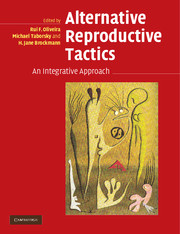Book contents
- Frontmatter
- Contents
- List of contributors
- Preface
- 1 The evolution of alternative reproductive tactics: concepts and questions
- PART I ULTIMATE CAUSES AND ORIGINS OF ALTERNATIVE REPRODUCTIVE TACTICS
- 2 Alternative reproductive tactics and the evolution of alternative allocation phenotypes
- 3 Phylogenetic analysis of alternative reproductive tactics: problems and possibilities
- 4 Modeling alternative mating tactics as dynamic games
- PART II PROXIMATE MECHANISMS OF ALTERNATIVE REPRODUCTIVE TACTICS
- PART III TAXONOMIC REVIEWS OF ALTERNATIVE REPRODUCTIVE TACTICS
- PART IV EMERGING PERSPECTIVES ON ALTERNATIVE REPRODUCTIVE TACTICS
- Index of species
- Subject index
- References
4 - Modeling alternative mating tactics as dynamic games
Published online by Cambridge University Press: 10 August 2009
- Frontmatter
- Contents
- List of contributors
- Preface
- 1 The evolution of alternative reproductive tactics: concepts and questions
- PART I ULTIMATE CAUSES AND ORIGINS OF ALTERNATIVE REPRODUCTIVE TACTICS
- 2 Alternative reproductive tactics and the evolution of alternative allocation phenotypes
- 3 Phylogenetic analysis of alternative reproductive tactics: problems and possibilities
- 4 Modeling alternative mating tactics as dynamic games
- PART II PROXIMATE MECHANISMS OF ALTERNATIVE REPRODUCTIVE TACTICS
- PART III TAXONOMIC REVIEWS OF ALTERNATIVE REPRODUCTIVE TACTICS
- PART IV EMERGING PERSPECTIVES ON ALTERNATIVE REPRODUCTIVE TACTICS
- Index of species
- Subject index
- References
Summary
CHAPTER SUMMARY
Alternative reproductive tactics may result from various causal mechanisms. This is relevant for the theoretician because the mathematical approach used to address the evolution of alternative mating tactics will be affected by the causal basis of the differential expression of these behavior patterns between (and within) individuals. In this chapter, we restrict our focus to alternative male mating tactics that are strictly controlled by short-term behavioral decisions. Based on a variation of the Lucas and Howard (1995) dynamic game-theory model, we show that a detailed understanding of five properties of a system with alternative reproductive tactics is important in understanding the evolutionary trade-offs associated with the choice among alternative mating tactics. These properties include (1) physiological or morphological state and how state is affected by the tactic chosen, (2) environmental conditions, (3) frequency- and (4) density-dependent attributes of the pay-offs derived from each tactic, and (5) time constraints that either directly affect the expression of a mating tactic or affect the pay-offs derived from those tactics. These five properties should be considered simultaneously, and we demonstrate how this can be done within the framework of a dynamic game. The model is extended to consider the evolution of graded signals. Our model suggests that the prediction of Proulx et al. (2002) that older males should have more honest signals is sensitive to assumptions made about environmental conditions and time constraints on future success. We end with a discussion of the level of detail that should be built into models.
- Type
- Chapter
- Information
- Alternative Reproductive TacticsAn Integrative Approach, pp. 63 - 82Publisher: Cambridge University PressPrint publication year: 2008
References
- 8
- Cited by



